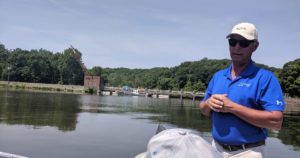Vermilion County SWCD and Aqua Illinois Collaboration
This month the Vermillion Co. Soil and Water Conservation District (SWCD) learned that their application for an IEPA watershed planning grant had been selected for funding. This grant will bring together $109,800 from IEPA, $40,000 from Illinois Farm Bureau, $20,000 from Aqua Illinois, plus in-kind contributions of $8,000 from the University of Illinois Extension and $7,920 from the Vermilion Co. SWCD. Together this will provide $185,720* dollars for the District to hire watershed consultant, Jeff Boeckler, to do a watershed inventory and plan for strategically implementing conservation practices in the Lake Vermilion Watershed, helping them determine where conservation agricultural practices will have the greatest impact.

Vermillion County Soil and Water Conservation District’s (SWCD) and Aqua Illinois have been working together to protect Lake Vermilion’s water quality since the 90’s. Lake Vermilion receives high levels of nutrients, from farm runoff and point sources like wastewater treatment plants in the surrounding watershed. This partnership started with District staff helping monitor nitrate levels in the North Fork of the Vermilion River that feeds into Lake Vermilion.
Nutrients like nitrate are used as fertilizer for growing crops. However, when it gets into drinking water it can cause blue baby syndrome where babies don’t get enough oxygen. People who chronically drink elevated levels of nitrate have also been found to have higher rates of certain cancers. It is therefore important to limit the amount of nitrate that gets into our water.
David Cronk, Lake Manager for Aqua Illinois’ water plant in Danville, IL says, “When people hear nutrient pollution they think about the dead zone in the Gulf of Mexico. However, it’s also causing issues for our drinking water as well, with high nitrate levels and contributing to toxic algal blooms. The Lake Vermilion Watershed is one of the highest for nutrients in the state.”
To address this issue, Aqua Illinois constructed a multi-million dollar nitrate removal treatment facility to deal with excess nitrates in the water. However, this is just a short-term solution. Cronk believes working with farmers to reduce nutrient runoff is the best way to protect the water quality for the long-term. The 319 grant will help to identify problem areas in the watershed and help to assist in reducing nutrient runoff.
Certain farming practices reduce the amount of fertilizer and soil that washes off farms when it rains. These include: cover crops, reduced tillage, and filter strips along buffers. Farmers can get technical support and financial assistance through the Vermilion Co. SWCD and the local Natural Resource Conservation Service (NRCS) office while learning new conservation practices. Many of these same practices also help farmers improve the health of their soil and the resiliency of their farm.
Watershed Planning Depends on Connecting with Local Landowners and Farmers
The watershed consultant, Jeff Boeckler from Northwater Consulting, has previously done watershed plans for other cities that depend on surface water for their drinking water, including Decatur and Springfield IL. Boeckler will do a lot of modeling; however, he strongly believes in the need to ground truth any model and will rely heavily on the District staff to connect with individual farmers and landowners to get on the ground information about how water is draining on the land. This connection will also be crucial for the future implementation of the plan.
Getting more conservation on the ground requires more than just financial and technical assistance, but having someone you trust available when you need them. In recent years, new USDA rules and budget cuts have led NRCS and SWCD staff to spend more time in the office doing paperwork rather than working with farmers out in the field. However, building relationships and working with farmers on their specific soil health and water quality concerns out in the field is some of the most valuable work they do. The strength of these relationships is what allows District staff to get new farmers involved in conservation.
*This blog post has been updated on 10/16 with revised dollar figures.







